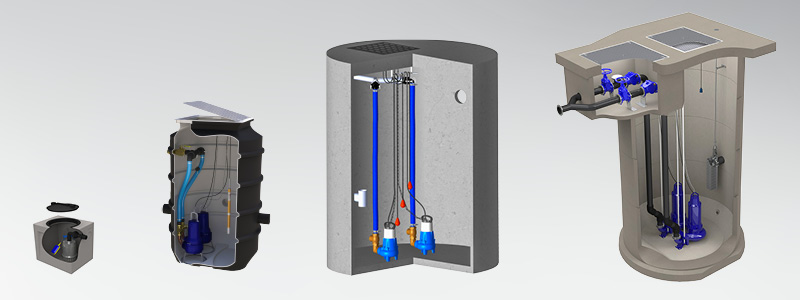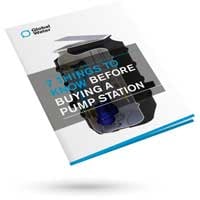In larger commercial developments, there is often the requirement for one or more pump stations when liquid is unable to be discharged under gravity. These devices act as a holding chamber to collect stormwater, sewage or another wastewater. The pump stations then transport the waste for reuse or disposal by utilising transfer pumps.

In Global Water’s latest blog, we outline some of the key considerations in designing a new pump station.
Where are pump stations used?
Pump stations can be installed in domestic, commercial, industrial or mining settings, and are available in a range of sizes from compact under-sink installations to industrial systems that transfer thousands of litres of liquid over long distances.
There are two common pump stations installed:
Stormwater Pump Stations
Stormwater pump stations collect rainwater run-off from a localised catchment area and boost it through discharge pipework when gravity discharge will not work due to distance or height difference.
Stormwater run-off either flows directly into an inlet grate in the top of the pump station, or on larger systems is piped underground to the pump station from catchment sumps or roofed areas.
The installation of a stormwater pump station prevents water ponding in a carpark or other paved area, and avoids flooding or overflow into adjoining properties . It also allows capture for subsequent reuse.
Sewage Pump Stations
Sewage pump stations are responsible for the at-source collection and transporting of wastewater and raw sewage via a rising main to the Municipal Authorities underground collection network.
What do I need to consider when selecting a pump station?
The Application
Before selecting any components for your pump station, it is critical that you understand what is being pumped, where the pump station will be located and where it will be discharging to. This will influence selections of both the station and pump size/s.
Also depending on which jurisdiction the pump station is being installed, whether it be council or Water Authority, there may be an approval process or certain requirements that must be adhered to. Each water authority and council may have different preferences. Your supplier may be able to advise you on these requirements.
Chamber Size
Next, consider the size of the chamber and the number of pumps required. For some applications, a single pump will be enough, however in multiple residential developments or larger commercial settings which may experience a large amount of stormwater or sewage, a twin pump system is recommended.
There is also a choice of the type of pump station; whether it be polyethylene, concrete or fiberglass there are advantages and disadvantages of all varieties depending on the application. Polyethylene stations are ideal for smaller applications where light weight and simplicity of installation are desirable. Concrete is used for larger applications and where crane access is not restricted, and fibreglass is generally only used for larger stations that need to be transported long distances.
Type of pump and electrical supply
Depending on the application and type of pump station, pump units are available in both single and dual configuration. To prevent pump blockages and ongoing maintenance issues, solids handling pumps are preferred, with Vortex pumps being used for stormwater and grinder or cutter pumps are used for sewerage applications. Flow rate required is determined by the catchment area and rainfall intensity in stormwater applications, or the number of users in sewage pumping. The pump discharge head requirement is governed by the difference in static height between the pump station and the discharge point, and the length of the rising main (friction loss). Your pump supplier can select the correct pump through a series of questions and resulting calculations.
As for power supply requirements, single-phase power supply is the standard, however larger flow rates may require three-phase power. Note that in critical installations where property flooding could occur if there is a power outage, battery backup power supply should be provided for the pump station.
Top tip: It is important your pump is reliable and durable and can handle the requirements of the application. If you undersize or oversize your pump selection or install a single pump where a dual pump is required, your client could be facing unnecessarily high energy costs, or high maintenance costs or even flooding.
Alarms required?
In some instances, an audible alarm is required to notify personnel of blockages or pump failure. These are generally added as an optional extra. Global Water suggest discussing the addition of an alarm with the client, as these devices can save a potential disaster by ensuring malfunctions are dealt with swiftly.
Top tip: discuss the ongoing maintenance costs associated with the pump station. Although following hand-over you may not be responsible for the asset, it would be worthwhile the client understands maintenance requirements. Local councils or Water Authorities may have set guidelines related to this.
Want to learn more?
Are you wanting to find out more about Pump Stations? Or maybe discover the range from Global Water? If you have an upcoming project that requires a sewage or stormwater pump station, get in touch with our team of experts. They can advise on best practice and ensure you are selecting the most reliable, durable and cost-effective solution for your project.
Tags: Polyethylene pump stations, Stormwater, Stormwater treatment, Concrete pump station




